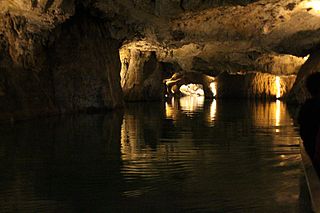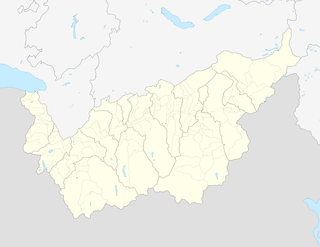Lac Souterrain de Saint-Léonard
| Lac basement
|
||
|---|---|---|
|
Lac Souterrain near Saint-Léonard (2009) |
||
| Location: | Saint-Léonard , Canton of Valais , Switzerland | |
| Height : | 509 m above sea level M. | |
|
Geographic location: |
598991 / 122773 | |
|
|
||
| Type: | natural underground lake | |
| Discovery: | 1943 by Jean-Jacques Pittard (first exploration) | |
| Show cave since: | 1949 | |
| Lighting: | Yes | |
| Overall length: | 300 m | |
| Website: | www.lac-souterrain.com | |
The Lac Souterrain de Saint-Léonard (German: underground lake of Saint-Léonard ) is the largest known natural underground lake in Europe with a surface area of 6,000 m 2 . The entrance to the cave is at the foot of vineyards in the commune of Saint-Léonard , between Sion and Sierre in the canton of Valais , Switzerland . The cave is visited by an average of 100,000 visitors per year.
With an area of 6,200 m 2 , the Seegrotte in Hinterbrühl in Lower Austria , which is divided into longitudinal and transverse tunnels, is slightly larger. However, this was caused by a sudden water ingress in the course of a blast for the underground mining of gypsum , so it was artificially created. In addition, the water level is lowered by continuously pumping out.
history
The grotto had been known to the residents of Saint-Léonard for a long time. The cave was first explored in 1943 by the Swiss cave explorer Jean-Jacques Pittard, who was accompanied by Jacques Della Santa.
When the cave was discovered, the water level was a few meters higher than it is today and almost reached the ceiling. On January 25, 1946, an earthquake occurred around Sierre with a magnitude of 5.5 to 6 on the Richter scale . The earthquake changed the hydrological conditions of the cave and its surroundings, which led to the lowering of the lake level.
As early as 1949, the cave was opened to visitors by two locals. Since then, boat trips have been offered on the lake.
In the winter of 2000, a two-ton rock loosened from the ceiling and the cave was closed by the authorities. In extensive renovation work for over 2.5 million Swiss francs , the cave ceiling was secured by inserting several thousand large and small rock anchors . In 2003 the cave was reopened to visitors.
Structure of the cave
The length of the lake is 300 m and the width is 20 m. At its widest point, the lake is 29 m wide. It covers an area of 6,000 m 2 . The water temperature is a constant 11 degrees. At the end of the navigable cave, the way forward is largely blocked by fallen boulders. Behind it there are further small halls, which are all above the water level in the dry rock. These caves, discovered in 1956, are not accessible to visitors.
The rock of the cave consists of plaster of paris , slate and marble . The cave owes its creation to the dissolution of the gypsum masses caused by the penetrating water. The residue of the dissolution process consists of iron-containing clay , which seals the lake bed.
Animal finds
Bats are the only larger animals that occur naturally in the cave. Only trout that have been settled by the shipping company and are regularly fed live in the lake.
literature
- André-H. Grobet: The underground lake of St-Leonard. Sion, 1993
Web links
- Lac Souterrain Saint-Léonard website. (German, French, English).
- Dale Bechtel: Subterranean lake comes back from the dead. In: swissinfo.ch . June 16, 2003 (report on the 2003 repairs).
- Boat trip on the underground lake. Switzerland tourism
- Franz Lindenmayr: Man and Cave: The underground lake of St-Léonard, Wallis, CH, and its surroundings. In: lochstein.de. (private page with pictures of the cave).
- Fare Moana: Europe's underworlds: The Lac Souterrain. In: Deutsche Welle . May 19, 2016 (also as mp4 video , 23.5 MB, 5:02 minutes).



